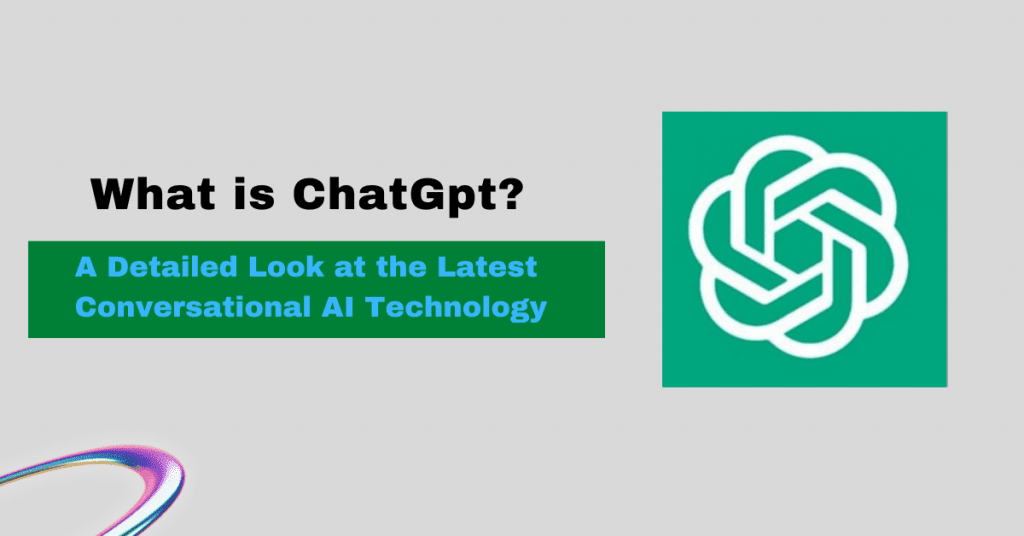What is chatGPT: A Detailed Look at the Latest Conversational AI Technology


ChatGPT is a natural language processing (NLP) model developed by OpenAI. It is based on the GPT (Generative Pre-trained Transformer) architecture and is designed to generate human-like text, specifically for conversational AI applications. In this article, we will take a detailed look at chatGPT, its capabilities and potential use cases.
Background
The GPT (Generative Pre-trained Transformer) architecture was first introduced in 2018 by OpenAI in a paper titled “Language Models are Unsupervised Multitask Learners”. This model was trained on a large corpus of text data called the “WebText” dataset, which consists of web pages scraped from the internet. By training on this dataset, the model was able to learn about a wide range of topics and acquire a vast amount of knowledge.
The next iteration of the model GPT-2 was released by OpenAI in 2019, with even more powerful performance than the original. However, due to concerns about its potential misuse, the full version of the model wasn’t release to the public.
The third version of GPT named GPT-3 was released in 2020, which gave the public access to play with the model and fine-tune it for different NLP task.
What is chatGPT
chatGPT is a variation of GPT-3 that is specifically designed for conversational AI. It is capable of understanding the context of a conversation and generating text that is relevant to the topic of the conversation. With its ability to understand and respond to a wide range of topics, it has the potential to be used in a variety of applications such as customer service chatbots, virtual assistants, and social media bots.
Capabilities of chatGPT
- Contextual understanding: One of the primary capabilities of chatGPT is its ability to understand the context of a conversation and generate relevant responses. This makes it ideal for use in chatbot applications.
- Language generation: chatGPT is able to generate coherent and human-like text, making it a valuable tool for creating realistic chatbot interactions and other conversational AI applications.
- Multi-Tasking: chatGPT can also be used for tasks such as language translation, text summarization, and question answering.
- Fine-tuning: chatGPT can adapt to new data quickly. Fine-tuning the model on a smaller dataset for a specific task or industry can help chatGPT perform even better and more accurately.
Potential use cases
- Customer service chatbots: chatGPT can be used to create chatbots that are able to understand and respond to customer inquiries.
- Virtual assistants: With its ability to understand and respond to natural language input, chatGPT can be used to create virtual assistants that can help users with a wide range of tasks.
- Social media bots: chatGPT can be used to create social media bots that are able to engage in conversations with users and respond to their inquiries.
- Language generation: chatGPT can be used to generate human-like text, making it a valuable tool for tasks such as automated content generation and language translation.
One of the most significant advantages of chatGPT is its ability to understand and respond to long-form text, which is critical for tasks such as question answering, text summarization, and language translation. This makes chatGPT a valuable tool for building advanced conversational systems that can understand and respond to more complex and nuanced queries.
In terms of its potential applications, chatGPT can be used to build highly efficient and sophisticated customer service chatbots that can handle a wide range of customer inquiries. It can also be used to create virtual assistants that can help users with tasks such as scheduling appointments, making reservations, and providing information. Additionally, chatGPT can be used to generate automated content for social media platforms, which can help businesses engage with their customers in a more personalized and efficient manner.
In conclusion, chatGPT is a powerful conversational AI technology that has the potential to revolutionize the way we interact with machines. Its ability to understand and respond to natural language input, generate human-like text, and adapt to new data quickly makes it a valuable tool for a wide range of industries and applications. With the ongoing developments in NLP and AI, we can expect even more advanced and sophisticated versions of chatGPT in the future.
Another potential application of chatGPT is in the field of education. chatGPT can be used to create virtual tutors that can provide personalized assistance to students. It can also be used to generate educational content such as quizzes, flashcards, and lesson plans. Furthermore, chatGPT can be integrated into virtual reality environments, allowing for more immersive and interactive learning experiences.
In the field of entertainment, chatGPT can be used to create virtual companions and avatars that can engage in conversations with users. It can also be used to generate personalized recommendations for movies, music, and other forms of media.
In the field of healthcare, chatGPT can be used to create virtual health assistants that can provide information about symptoms and treatments, and even help schedule appointments with doctors. It can also be used to generate personalized health plans and medication schedules.
In addition, chatGPT can be used in the field of finance, to create virtual financial advisors that can help users with budgeting, investment planning and providing financial information.
It’s also worth noting that chatGPT is not only a standalone model, it can be used in combination with other AI technologies such as computer vision, to help chatbot identify images and other visual information.
In conclusion, chatGPT is an incredibly powerful and versatile technology that has the potential to transform a wide range of industries. Its ability to understand and respond to natural language input, generate human-like text, and adapt to new data quickly makes it an ideal tool for a wide range of applications including customer service, virtual assistance, social media, education, entertainment, healthcare, and finance. As the technology continues to evolve and improve, we can expect to see even more innovative and exciting uses of chatGPT in the future.